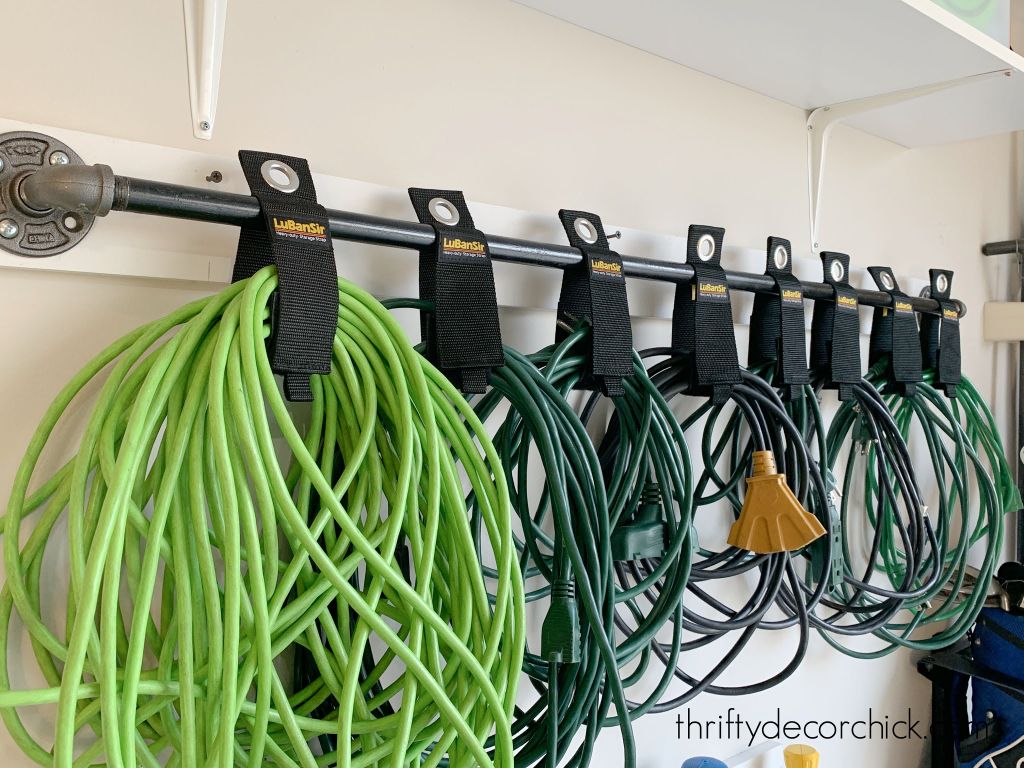Properly storing garage extension cords is important for organization, safety, and cord longevity. The ideal storage method keeps cords untangled, protected, and easy to access when needed. Here are some top tips for storing garage extension cords.
Page Contents
Why Proper Storage Matters
Taking the time to properly store extension cords makes the garage a safer and more functional space. Here are some key reasons to use proper storage techniques:
- Prevents Tripping Hazards – Cords left on the floor can cause people to trip and fall.
- Reduces Clutter – Organized cords keep the garage neater.
- Saves Time – Easy access to neatly stored cords avoids frustration.
- Prolongs Cord Life – Proper storage protects cords from damage.
- Fire Safety – Safely storing cords reduces fire hazards.
Garage Cord Storage Tips
Use Hanging Storage
Hanging storage gets cords up off the floor and neatly organizes them. Some good hanging storage options include:
- Wall-Mounted Hooks – Screw sturdy hooks into garage walls or joists to hang cords.
- Track Storage – Mount a track system with movable hooks to hang cords.
- Cable Spools – Use commercial spools designed to hold extension cords.
- Pegboards – Use pegboard panels with hooks to store cords.
Coil Cords Neatly
Before hanging cords, neatly coil them to prevent tangles and knots. Here are some tips for coiling cords:
- Make rounded coils rather than kinked folds.
- Coil the cord loosely rather than tightly.
- Use velcro straps or twist ties to secure coiled cords.
- Make sure coils are large enough in diameter to prevent kinks.
Label Cords
Labeling extension cords makes it easy to identify the right cord for the job. Some labeling options include:
- Printed labels with cord length and gauge
- Colored tape to code different cords
- Tags attached to cord plugs
- Permanent marker writing directly on the cord
Store Vertically
Where possible, store coiled cords vertically rather than horizontally. Vertical storage saves space and keeps cords from getting entangled.
Consider Cord Reels
Retractable cord reels provide an convenient option for accessing cords quickly and storing them neatly. Mounted reels keep cords up off the floor. Look for reels designed for garage use.
Protect Cord Ends
Use plug and connector protectors to keep cord ends safe from damage. Protectors cap off ends and prevent moisture, dust and debris from getting into sockets.
Untangle Before Storing
Always untangle cords fully before coiling them for storage. Leaving twists and knots makes cords prone to tangling again.
Avoid Hanging Near Heat
Don’t hang cords near heat sources like hot water tanks and furnaces. High heat can damage cords over time.
Consider Cord Length
Take cord length into account when coiling and storing. Shorter cords can use smaller coils, while longer cords need larger coils.
Keep Cords Clean
Clean dirty cords before storing to prevent grease, dirt and grime from accumulating. Use mild soap and water.
Garage Cord Storage Solutions
Here are some specific storage solutions to keep garage extension cords neatly organized and easily accessible:
Wall-Mounted Lumber Racks
Lumber storage racks provide dedicated vertical space to store coiled extension cords. Mount racks securely to garage walls and label each space.
Over-the-Door Storage
Over-the-door storage racks and hangers provide quick access to cords right where you need them. Use multiple hooks for neat cord storage.
Shelving
Free-standing shelving units are ideal for organizing coiled cords. Place coils upright on shelves near garage outlets.
Storage Cabinets
Plastic cabinets with drawers or bins allow categorized storage of different extension cords. Label drawers for easy identification.
Pegboards
Pegboard panels mount to walls and provide customizable storage using hooks, baskets and clips. Use them to neatly organize coiled cords.
Retractable Reels
Spring retractable reels provide quick, easy access to cords. Mount them to ceiling or wall so cords are up and out of the way.
| Storage Method | Pros | Cons |
|---|---|---|
| Wall Hooks |
|
|
| Track Storage |
|
|
| Cable Spools |
|
|
| Pegboards |
|
|
| Retractable Reels |
|
|
Key Steps for Storing Cords
Follow these steps whenever coiling and storing extension cords:
- Inspect cord for damage and cut away any cracked areas.
- Clean cord to remove dirt, grease and debris.
- Untangle cord completely before coiling.
- Coil cord neatly in rounded loops to prevent kinks.
- Secure coils with velcro straps or twist ties.
- Label cord based on length and gauge.
- Store vertically on hooks, racks or spools.
- Protect ends with connector caps.
Storing Multiple Cords
Follow these tips when storing multiple garage extension cords:
- Group same-length cords together for easy identification.
- Hang cords of different gauges separately to avoid cord confusion.
- Allow enough space between coiled cords for easy access.
- Label cords clearly to identify size and length.
- Consider color-coding cords using colored tape.
Conclusion
Proper storage is essential for keeping garage extension cords tangle-free, protected, and readily accessible. Allow enough space to coil cords cleanly without kinks. Store cords off the ground on hooks, racks, spools or retractable reels. Label cords clearly and separate by size and length. Take time to neatly organize cords so they are ready to use when needed.
